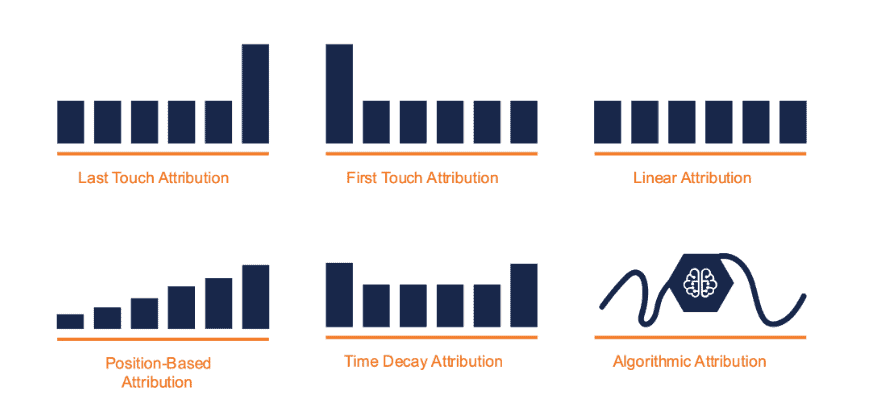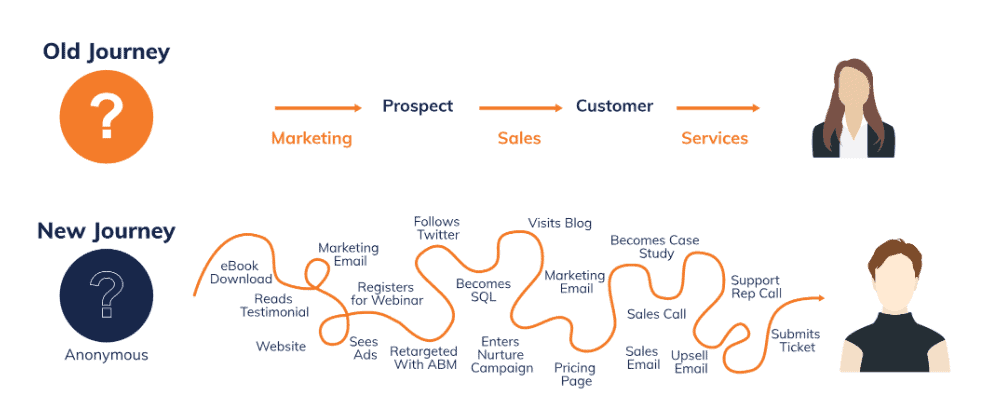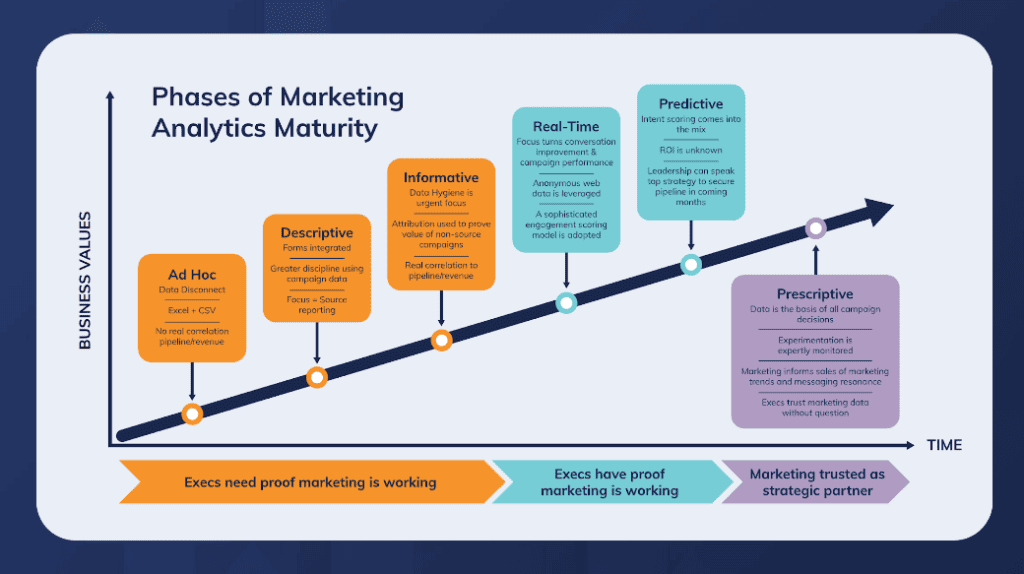
What if the data guiding your marketing decisions was flawed, and hidden data leaks sabotaged your ability to place good bets and grow your pipeline?
Are errors in tracking buyer journeys, attributing marketing campaigns, projecting pipelines, and calculating ROI leaking away your confidence, trust, and results? In this blog post, we’ll uncover the ten most frequent and impactful data leaks sabotaging B2B marketing performance and outline real fixes to seal them.
In the world of B2B marketing, clarity is power. When you can ‘See Better’ through the lens of analytics and attribution, you’ll be able to ‘Do More’—more targeted campaigns, more efficient spending, and see more impactful results. It’s about turning insight into action and seeing beyond the data fog that clouds many B2B marketing strategies today.

How Do You Measure B2B Marketing Attribution?
Measuring attribution in B2B marketing is about giving credit where it is due. Dozens of attribution models and tools will assign credit to a digital or offline campaign or tactic. B2B attribution measurement starts with choosing the right Key Performance Indicators and marketing attribution data model that aligns with your business goals. Specific marketing attribution models favor brand awareness and prospecting, while others focus on conversion or customer retention.
6 Types of B2B Marketing Data Attribution Models
Choosing a suitable marketing attribution model is crucial to avoid data leaks. Different models like “Last Touch Attribution” and “Algorithmic Attribution” can be used to evaluate the impact of each touchpoint in marketing. No single model is perfect and a combination of models may be required to precisely comprehend the marketing impact.

Modern B2B Buyer Journey Requires Better Marketing Attribution Models
As depicted below, buyer behavior has significantly changed, making marketing attribution more difficult. Today’s buyers may start as anonymous website visitors and interact with multiple marketing touchpoints before becoming a “hand raiser” ready to talk to sales. This complex journey presents a challenge for attribution, often leading to leaks in capturing the full value of each interaction. Recognizing the nuances of modern customer engagement is crucial in avoiding the misallocation of marketing resources and ensuring the success of marketing strategies.

Good B2B Marketing Attribution Leads to Optimized Marketing Spend
B2B marketing attribution models help determine what touch point gets the highest engagement. It allows marketers to adjust media budgets accordingly. By plugging the leaks and constantly optimizing marketing spend based on marketing attribution data, you can maximize the ROI and minimize the impact of investing in tactics that aren’t effective.
Link every B2B marketing action to business goals.
When building your B2B marketing plan, aligning business objectives, revenue growth, or new customer acquisition with your marketing efforts is essential. Connecting these dots helps you identify the levers that matter most to the business and, consequently, the right marketing metrics to measure. Linking marketing actions to business goals will also help you secure budgets for new initiatives by identifying the most effective channels/tactics to achieve your desired result.

Complete Data Drives Confident Decisions
Michael Tucker, Director of Marketing at NopSec, believes that accurate and complete data is crucial for confident decision-making. To win, a cohesive data narrative is essential. Narrow scopes or gaps hinder your ability to succeed. Common B2B Marketing Attribution Challenges and Mistakes
You can demonstrate the full impact of marketing-sourced revenue through reliable marketing attribution with reliable data and insights. Although B2B marketing attribution models offer many advantages, common mistakes can cause misattribution, obscuring marketing results. Read on to diagnose where your data pipelines might leak – and take back control with our 10-point checklist.
#1: Department-Centric Reporting Distorts the Full Buyer Journey
Siloed department metrics need to be revised to reflect the outcomes necessary for the success and growth of the business. For instance, your marketing team’s marketing attribution reports may show high MQLs. At the same time, the sales data reveals a low conversion rate to SALs, indicating a disconnect in the qualify of leads handed over from marketing to sales.
Fix: All departments must focus on the common goal of increasing revenue. Unify the company around conversion metrics and marketing attribution models closely linked to the health of the sales pipeline, such as high-quality MQLs, sales accepted leads (SALs), or opportunity creation. Additionally, it gives more weight to the signals that occur in later funnel stages.
#2: Not Tracking the Trigger Behind New Opportunities
Have you generated leads or sales and don’t know where they came from or what marketing touches aided the process? Unless your marketing team efforts can capture the vital first-touch and last-touch conversion triggers within the CRM, you cannot attribute what marketing mix drove pipeline growth, which means you won’t be able to optimize or scale performance.
Fix: Leverage campaign features in your CRM or marketing automation system to map prospect “tipping point” actions – email clicks, form fills, content downloads, etc. – to CRM objects tagging the campaign or asset source. Analyze the path-to-pipeline.
#3: Gaps in Pipeline Stage Progression Dates
Incomplete date stamping in the sales funnel can distort cycle times, skew predictability, and undermine planning accuracy. For instance, neglecting to record the transition date from Lead to Opportunity can lead to unreliable forecasts and pipeline velocity.
Fix: Besides tracking progression dates by stage; reps must log routine interactions in the CRM. This provides a clear timeline of buyer-seller engagement, such as emails, calls, meetings, demos, and pipeline progression.
#4: Dropped Marketing Attribution Data from Online Campaigns
When the digital footprints of users interacting with your marketing campaigns or visiting your website fall short, multi-channel attribution erodes, which hurts your ability to optimize campaigns. For example, if UTM data doesn’t pass as users navigate from the landing page to the main website, it leads to incomplete attribution data and missed insights.
Fix: Expand UTM tagging across sites and assets. Analyze the buyer journey stage-by-stage, not just last-click CPL.
#5: No Campaign Taxonomy Standards
Marketers tend to focus on what they can measure. However, when campaign data is disorganized and inconsistent, it becomes challenging to analyze the effectiveness of different combinations and optimize accordingly. For instance, when campaign and asset names and formats vary from one flight to another, it creates inconsistencies in punctuation, capitalization, dates, and other details. One campaign may be labeled as “Email_March2023,” while a similar campaign is tagged as “email_campaign_03_2023.” Such discrepancies can be confused when gathering and analyzing data, leading to muddled analysis and reporting down the funnel.
Fix: Maintain an up-to-date campaign taxonomy, including standards for nomenclature, structure, and conventions. Inform processes and train teams in integrity.
#6: Contact Data Gaps Cause Waste
Having complete and consistent contact records is crucial to successfully personalizing the customer experience, hypertargeting high-fit offers, and projecting renewals. However, when contact records are fragmented, they often need more critical information like industry or job roles. Missing data like this often results in waste, lost personalization, and the inability to calculate lifetime value.
Fix: Establish consistent mandatory contact/account data requirements by persona. Routinely augment records through both automation and deputized marketing team member updates.
#7: Failing to Factor Marketing Technology and Talent Costs
To accurately determine the profitability of marketing campaigns, it’s crucial to consider all the associated costs. These costs may include salaries, martech licensing, data services, and marketing analytics overhead and should be treated as cost of goods sold (COGS). Focusing solely on advertising media expenses can result in an inaccurate view of the return on investment (ROI). For example, a “$20 CPL” may seem excellent until you account for an additional $140 in operational expenses for generating and nurturing that lead.
Fix: Rigorously factor broader operational costs across marketing teams, tools, and systems integral to marketing execution as net campaign COGS. Align budget requests to true returns.
#8: Not Collecting Qualitative Inputs to Determine Influence
Gathering qualitative insights to understand what generates demand for your solution entirely is essential. Sometimes, you may assume that your leads come from specific B2B marketing channels like Search or Direct. Still, they could originate from other touchpoints that aren’t tracked or included in the marketing attribution model, such as comments, podcasts, Slack, videos, and more. Not fully considering the entire customer journey may prevent you from realizing the full impact of your multi-channel strategy, leading to suboptimal decisions on media mix and budget allocation.
Fix: Add “How did you hear about us?” to your website intake forms. Gather customer feedback through post-purchase/renewal online and offline interactions.
#9: Jumbling Lead Gen Sources, Offers, and Conversion Types
Improper categorization of lead generation sources, content offers, and conversion actions can lead to inaccurate data segmentation. When various lead sources are grouped under a single category without distinguishing between marketing channels such as email, social media, and webinars, it becomes difficult to determine which specific marketing channels are most effective. With a clear taxonomy schema, it becomes easier to discern channel efficacy, and sound data segmentation becomes slippery. For instance, lumping “Content Syndication” conversions together with “Chatbot Interactions” and “Demo Meeting Requests” can limit analyzing performance by specific marketing channels and offers.
Fix: Institute taxonomy distinguishing conversion types (demo, contact event, etc.), lead gen source (email nurture, event, etc.), and content offers (eBook, ROI tool, etc). Standardize tags in CRM and data analytics.
#10: Contacts Not Affiliated to Deal History
It’s crucial to link all contact records to relevant deals for practical customer experience evaluation and retention strategies. Duplicate buyer contact records across different systems can lead to disjointed conversion events, making identifying renewal potential, changing channel preferences, and upselling opportunities difficult. This could lead to inaccurate insights, predictive models, and personalized experiences, increasing the risk of losing out on opportunities.
Fix: Implement CRM workflows and train the Sales team to link contacts and deal associations. Enable augmenting enriched, integrated profiles with every new deal created to track loyalty.
Fix Revenue Leaks Before They Drain Returns Dry
With each data leak sealed, you not only ‘See Better’ into the intricacies of your B2B marketing efforts but also unlock the potential to ‘Do More’ with every marketing campaign. It’s about transforming insights into placing better bets for your business.
Marketing teams must vigilantly monitor data hygiene. Your marketing data analytics are only as good as the B2B marketing attribution models you use and the underlying data quality. Clean “pipes” enable healthy performance measurement, decision-making, and experience orchestration flowing through the funnel.
With CRMs and automation tools now more powerful and accessible than ever, even smaller marketing teams can safeguard data integrity. Doing so earns leadership trust in marketing ROI plus internal respect for the insights you supply – leaks no longer erode the potency of your data.
We hope this 10-point checklist helps you identify where leaks often hide, diagnose your exposure, and tackle them in priority order. We’d love to hear what holes or examples resonate with your reality and what you plan to tackle first.
Data Analytics in Marketing Maturity
Finally, you should consider the “Phases of B2B Marketing Analytics Maturity” to progress your B2B marketing efforts from the “Ad Hoc” to “Prescriptive” stages. You’ll transition from fixing leaks to leading with data by working towards growth through these phases. Understanding attribution maturity will help position you and your team as a strategic partner in driving business growth.

Key B2B Marketing Attribution Takeaways to Plug Leaks and Grow Pipeline
Don’t have time to read the entire article? Here are the key takeaways to identify and plug leaks to help you See Better and Do More.
- Attribution Accuracy: Ensure your marketing decisions are guided by accurate attribution models that reflect actual performance and align with your business goals.
- Unified Reporting: Break down silos by unifying metrics across departments, focusing on shared goals like high-quality lead conversions and revenue growth.
- Data Integrity: Regularly check for and fix gaps in data tracking and CRM timestamps to prevent skewed analytics and preserve pipeline predictability.
- Invest in Data Hygiene: Maintain a clean and standardized campaign taxonomy and ensure contact data completeness to enhance personalization and targeting.
- Operational Cost Awareness: Include all marketing-related expenses in ROI calculations for a realistic view of campaign profitability.
- Multi-Channel Insight: Collect quantitative and qualitative data across all touchpoints for a holistic view of your marketing impact.
- Advance Analytics Maturity: Progress through the stages of marketing analytics maturity, shifting from reactive problem-solving to strategic data-driven decision-making.
Improve Your B2B Marketing Campaigns and Grow Pipeline
As you seal these data leaks and sharpen your marketing vision, the mantra ‘See Better. Do More.’ becomes our reality. Better visibility into our marketing efforts isn’t just about understanding—it’s about empowerment. With more precise insights comes the power to execute more effective strategies, drive higher ROI, and deliver the growth your business can achieve.
Ready to ‘See Better’ and ‘Do More’? Reach out to Vende Digital for a strategic planning session. You’ll gain the clarity to take bold actions that drive substantial results. Let’s elevate your marketing from a mere function to a strategic powerhouse. Partner with us and transform insight into impact.
